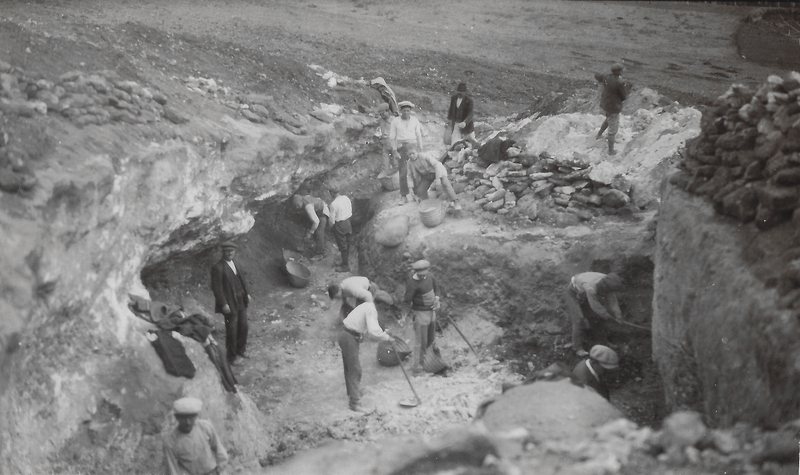The Hill of Tsoungiza
Carl W. Blegen and his team explored more than the area immediately surrounding the Sanctuary of Zeus and the Stadium – based on reports of finds from locals as well as “[v]illage tradition” (Blegen 1924, 18), they also explored the nearby hill known as Tsoungiza. Here, even in 1924, the team found considerable quantities of Bronze Age pottery littering the surface. They collected even more from a few trenches they opened, but they did not find any associated architecture.
The results of the 1925 season revealed a “most unexpected discovery” (Blegen 1926, 133) – a natural “cave” filled with vast quantities of pottery. The “cave” itself was also of considerable size. Blegen describes the first pit they excavated as approximately 4 by 5 meters but was 4.40 meters (approximately 14.5 feet) deep when they reached the bottom. Blegen and crew fully excavated the “cave” in 1926 by expanding the area, and they collected an enormous amount of pottery.
These sherds, the vast majority of which could be reconstructed to form nearly complete vessels, were all dated by Blegen to the Early Neolithic period (between about 6500 and about 5800 B.C.E.). One such vessel is N-017; most of the vessel is complete, although the missing areas are clearly visible. One aspect not revealed by the black and white photo is the variegated pattern on the surface. A watercolor painting by Piet de Jong, done probably in 1933 or 1934, depicts the reddish-brownish colors at the top and the darker colors toward the bottom. De Jong only painted a few examples of the pottery found, but those paintings reveal the richness of the decoration.
Blegen also discussed the non-pottery finds found in the “cave.” Obsidian, flint, and decorative objects made from different stones were all found along with numerous animal bones. Human remains were also found, and at the time, they were the earliest known human remains yet found in Greece.
The excavation of the hill in 1926/1927 was entrusted to a then-employee of the Department of Classics at the University of Cincinnati, James P. Harland. Harland returned to the exploratory trenches from 1924, and he uncovered not only pottery from the entire Bronze Age (from about 3200 to about 1050 B.C.E.), but also architecture from each major period of the Bronze Age (the Early, Middle and Late Helladic periods). While Blegen notes Harland’s finds in his 1927 preliminary report, Harland never published the findings – the only appearance in print is an abstract of his presentation at the 1927 Annual Meetings of the Archaeological Institute of America (Harland 1928, 63). James C. Wright and Mary K. Dabney did publish his results as a chapter in their 2020 volume, utilizing not only Harland's manuscript, but also his logbooks, other notes, and photographs. Because of their own work at the site, they could state "we can cataegorize the finds and place the excavations more precisely in their archaeological context than Harland would have done" (Wright and Dabney 2020, p. 309).
For a more recent discussion of the Neolithic portion of the site and why it was not a "cave," see Mary K. Dabney, et. al 2020. The authors also date the pottery more accurately than Blegen was able to do in the 1920s and 1930s.





